History of International Liquid Crystal Society
The following article about ILCS history has been written by David Dunmur and Heinz Kitzerow on the occasion of the 25th anniversary of ILCS. The article was published in Liquid Crystals Today journal.
The International Liquid Crystal Society 1990 - 2015
A date in March 2016 will mark the 25th anniversary of the registration of the International Liquid Crystal Society as a not-for-profit corporation in the State of Ohio, USA. This was the legal establishment of the ILCS, which followed a declaration made during the 13th International Liquid Crystal Conference held at the University of British Columbia, Vancouver in July 1990. After 25 years and a further 12 international conferences it seems appropriate to record how the ILCS came into existence, review its successes, and to identify some of the challenges the Society faces in the coming years.
The first designated International Liquid Crystal Conference was organised in 1965 by Professor Glenn Brown of Kent State University Ohio at his home Institution, and in subsequent years the conferences became established as biennial events. The organisation of successive conferences was taken on by the host institutions, and the detailed administrative work associated with the conference was done by local organising committees, led by distinguished liquid crystal scientists. In due course, the International Liquid Crystal Conferences (ILCC) were overseen by an International Planning and Steering Committee (IPSC) formed from former ILCC chairmen and other notable liquid crystal scientists. This committee was an ad hoc group, membership of which was by invitation, and whose legitimacy and authority derived from the scientific distinction of its serving members.
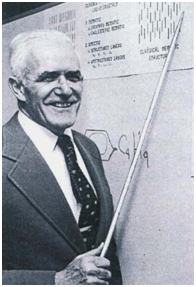
Professor Glenn Brown 1915 - 1995
In fact, there had been International Liquid Crystal Conferences before the 1965 meeting held at Kent State University. Perhaps the most famous one was that held at the Royal Institution, London in 1933, organised by the Faraday Society as the 58th General Discussion under the title of “Liquid Crystals and Anisotropic Melts”. The Chairman of this conference was Dr N V Sidgwick FRS, not a liquid crystal scientist, but President of the Faraday Society at the time. The host of the conference was Sir William Bragg OM, FRS, Director of the Royal Institution, and the programme contained contributions from many of the pioneer liquid crystal scientists from the early decades of the 20th century. The conference and its important impact on liquid crystal science has been reviewed1, but it is now clear2 that the 1933 Faraday General Discussion on Liquid Crystals was in fact a restaging in London, and in English, of an earlier virtual symposium conducted through the pages of Zeitschrift für Kristallographie, volume 76, published in 1931. Many of the authors and the subject matter of their contributions are similar in both the published proceedings of the London Faraday General Discussion3 and the earlier volume of Zeitschrift für Kristallographie.4
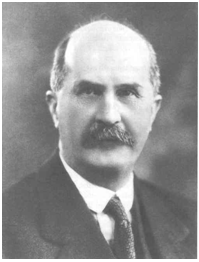
Sir William Bragg 1862 - 1942
Even before 1931, in the earliest days of research into their properties, liquid crystals had made appearances at scientific meetings. One meeting in particular was the 1905 annual conference of the German Bunsen Society for Physical Chemistry. Though not an international conference in the sense we now understand, there were contributors from different countries. The meeting was held in Karlsruhe, the home city of Otto Lehmann, and during the sessions the subject of liquid crystals got an airing; it was not, however, an edifying occasion. The Chair of the conference was the President of the Society, Professor Jacobus H van’t Hoff, the first Nobel Laureate in Chemistry in 1901. He presided over bad-tempered exchanges between Dr R Schenk, who had delivered a paper on Lehmann’s liquid crystals, and Dr G Tamman from Göttingen who was convinced that the “so-called” liquid crystals were impure colloidal mixtures of birefringent particles in an isotropic fluid. Tamman’s contempt for the work of Schenk, and by implication of Lehmann, is epitomised in the remark of Tamman during that meeting5:
“…There are certainly such things as soft crystals. I am happy to concede flowing crystals, but liquid crystals, never.”
The discussion during the meeting was inconclusive, Lehmann himself failed to get an opportunity to speak, and in closing the discussion, Chairman van’t Hoff proposed the setting up of a Commission of Experts to resolve the uncertainty surrounding liquid crystals.
“…There are certainly such things as soft crystals. I am happy to concede flowing crystals, but liquid crystals, never.”
The discussion during the meeting was inconclusive, Lehmann himself failed to get an opportunity to speak, and in closing the discussion, Chairman van’t Hoff proposed the setting up of a Commission of Experts to resolve the uncertainty surrounding liquid crystals.
There is one further significant meeting, at least for the English-speaking sector of liquid crystal researchers, which had a hint of internationality. A second General Discussion of the Faraday Society was organised in Leeds in April 1958 with the title “Configurations and interactions of macromolecules and liquid crystals”.6 The meeting was largely organised by J D Bernal, but chaired, as was customary at the time, by the Society’s President, Sir Harry Melville. The overseas visitors included notable liquid crystals scientists such as W Maier, A Saupe, V Luzzati and A de Vries. Among the British participants were G W Gray, A S C Lawrence and F C Frank, and the latter presented a paper at the meeting on the elastic theory of liquid crystals.
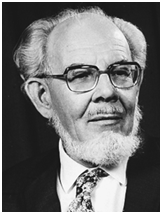
Sir Charles Frank 1911 - 1998
The need for scientists to exchange information and views through conferences is self-evident, and resulted in the establishment in 1965 of the series of International Liquid Crystal Conferences, as noted above. The table below gives the complete list of such conferences up to the present. As well as the international conferences, there were regional, national and local meetings and conferences on liquid crystals, which brought together liquid crystal researchers in different parts of the world to discuss the rapidly growing field. The driving force for these “specialist” meetings on liquid crystals was the interdisciplinary nature of the research involving chemists, physicists, biophysicists, and, increasingly as the years passed, electronic engineers and display technologists. Established groupings of scientists in physics, chemistry and electronics could not satisfy the compelling requirement to present the results of research in the rapidly expanding field of liquid crystals.
Table 1 International Liquid Crystal Conferences
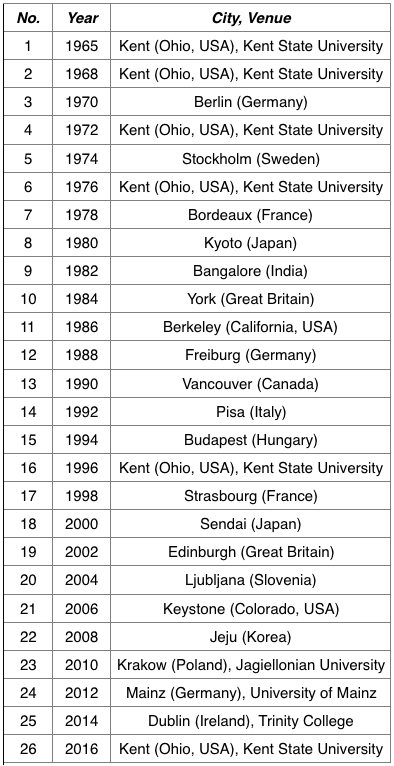
Liquid crystal conferences provided the desired forum for scientists from a variety of disciplines to share their results and develop new lines of research. Why then was it necessary to formalise the interdisciplinary research groupings by forming liquid crystal societies?
We all self-righteously believe that we are motivated in our scientific work by the quest for knowledge and understanding, but in reality the driving forces for research are more prosaically the need for funding and recognition. In the modern scientific world, the funding streams for research are fairly well-defined, and not surprisingly the source of finance for research is controlled by established groupings of scientists. This inevitably provides a hurdle to revolutionary ideas, and in particular the natural conservatism of individuals and institutions, and their self-interest, has been a big impediment to funding interdisciplinary research in many areas. There is now widespread recognition of this problem, and funding institutions try to recognise that diversity in scientific research is essential for progress, but their response is usually too little and too late. By the same token, recognition through papers accepted for publication by established journals, and awards for scientific achievements, tend to discriminate against emerging fields of research, especially those that fall outside conventional subject areas. It is not surprising then that groups of scientists in interdisciplinary science have come together to create their own societies, journals and awards. What was surprising was the grass-roots desire to form societies for liquid crystals: it is inconceivable that there could have been similar motivations for the formation of a society for gases, or liquids, or solids.
After World War II, groups of scientists in countries all over the world came together, informally or formally, to discuss their mutual interests in liquid crystals. Two prominent regular meetings were the Freiburg Liquid Crystal Workshop (Freiburger Arbeitstagung Flüssigkristalle), and Les Houches Summer School in Condensed Matter Physics, which dealt with many aspects of liquid crystal physics. In some countries, groups of scientists founded national liquid crystal societies, and the first was the Chinese Liquid Crystal Society (CLCS) founded in 1980 by Zhao Jian-An, Ruan Liang, Xie Yu-Zhang and Lui Lam (also known as Lin Lei). The first national society in the western hemisphere was the British Liquid Crystal Society, founded under the chairmanship of Professor Frank Leslie in 1985. The benefits of such societies were regular meetings devoted to liquid crystal research, opportunities for training young researchers, the institution of awards at various levels, and above all the increased profile that liquid crystal research achieved nationally. The societies also constituted a legal entity which could raise funds and use them to promote the science of liquid crystals in a variety of ways.
The idea for an international society came from Lui Lam, one of the founding members of the Chinese Liquid Crystal Society. In the 1980s, Lui Lam, having an educational background from Hong Kong, British Columbia, Canada and New York, became a successful and increasingly prominent liquid crystal scientist. Born in China, Lam joined the International Planning and Steering Committee (IPSC) in 1984, and he was keen to democratise the committee and make it truly representative of the international community of liquid crystals scientists. Lui Lam has published a personal account of the formation of the International Liquid Crystal Society, and his role in its launch.7
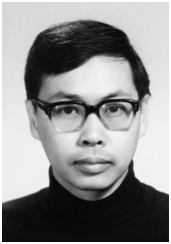
Professor Lui Lam (Lin Lei)
In 1988 Lui Lam solicited support from liquid crystal scientists around the world for the formation of an international organisation to serve the liquid crystal community. A petition was prepared to be presented at the 12th International Liquid Crystal Conference to be held in Freiburg in August 1988. The petition was signed by 82 scientists including a substantial number of the members of the International Planning and Steering Committee. It was confidently expected that the International Society would be officially inaugurated at the 1988 Freiburg conference, which marked the centenary of the discovery of liquid crystals by Friedrich Reinitzer, but it was not to be. Dissenting views on the Planning and Steering Committee stalled the formation of the society, but the overwhelming support from participants at the conference meant that the Planning and Steering Committee committed itself to a transmutation into the International Liquid Crystal Society. A sub-committee consisting of S Chandrasekhar, W Doane, A Fukuda, S Lagerwall and L Lam was charged with bringing forward proposals to effect the transformation. These were duly presented at the next (13th) International Liquid Crystal Conference held during July 1990 at the University of British Columbia, Vancouver, Canada.
At the meeting of the International Planning and Steering Committee (IPSC) held during the 13th ILCC, the proposal was made and approved that the IPSC be transformed into the International Liquid Crystal Society. The campaign led by Lui Lam to form an international society for liquid crystals had been successful.
At the meeting of the International Planning and Steering Committee (IPSC) held during the 13th ILCC, the proposal was made and approved that the IPSC be transformed into the International Liquid Crystal Society. The campaign led by Lui Lam to form an international society for liquid crystals had been successful.
The first Officers and Board of the new ILCS were drawn from the old IPSC, with a few additions. S Chandrasekhar was the President, M Schadt the Vice-President, the Secretary was D Dunmur and the Treasurer W Doane. L Lam was appointed as Chairman of the Conference Committee, which took over the previous function of the IPSC. So with the approval of the attendees at the 13th international conference, the ILCS was formed, and although it had Officers (appointed) and a Board of unelected Directors, the Society had no members. Participants at the Vancouver meeting had been invited to apply for membership, and in the months following i.e. during the autumn of 1990, various procedures were put in place to deal with membership applications. There was a constitution (Book of Rules) and in due course Bill Doane as Treasurer was able to collect the necessary papers to register the ILCS as a not-for-profit corporation in the State of Ohio. One of the defined functions of the new society was to publish a newsletter, Liquid Crystals Today, that would be distributed to all members.
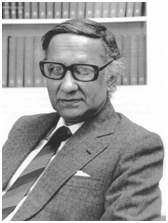
Professor Sivaramakrishna Chandrasekhar 1930 - 2004
The first issue of Liquid Crystals Today (Editor David Dunmur) was published in January 1991, and the founding officers and board directors at that time were listed. The Treasurer, Bill Doane, was able to report that the new ILCS had about $28,000 and that papers were complete to incorporate the ILCS as a not-for-profit corporation in the State of Ohio. In the same issue, membership applications were invited. The Society came into existence formally around March 1991 with the filing of legal documents in the State of Ohio. In the second issue of Liquid Crystals Today (June 1991), it was recorded that the membership stood at 200, and the affiliation of national societies was invited; the first international conference held under the auspices of the ILCS was the 14th ILCC in Pisa in 1992.
Table 2 Founding Officers and Board Directors
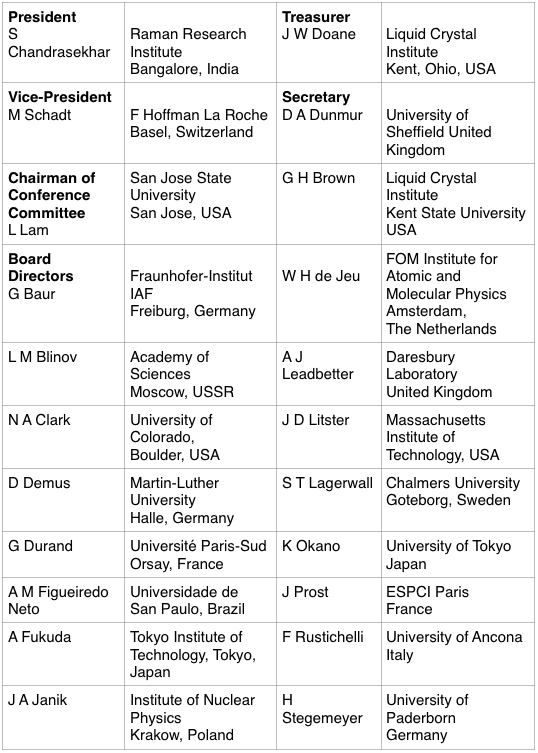
Over the years, the membership of the International Liquid Crystal Society has approached 1000 from nearly 50 countries. The Society has helped to create an international community of liquid crystal scientists, and their activities have been documented in the Society’s newsletter, Liquid Crystals Today. These activities can be followed through the pages of Liquid Crystals Today (LC Today), now in its 25th year. In 1995 Taylor and Francis took over the publication of LC Today, and in the year 2000 the newsletter became an e-journal. Changes of officers and board members are recorded in LC Today, as are the recipients of various awards for liquid crystal science instituted by the Society. News items and reviews give a flavour of the development of the science of liquid crystals through two and a half decades, but occasionally events of worldly significance have impinged on our activities, and been recorded in Liquid Crystals Today.
In 1991, there were dramatic political changes in parts of Eastern Europe. During the period May 27th to June 2nd the “White Nights Liquid Crystals Conference” was organised on a comfortable ship cruising the lakes of Onega and Ladoga from its base in Leningrad. It was the first international meeting on liquid crystals organised in Leningrad, and also the last, since later in the year the USSR collapsed and Leningrad reverted to its former description as St Petersburg. The summer European Liquid Crystal Conference held over the period August 19th to 23rd 1991 was the first following the amalgamation of the Liquid Crystal Conferences of Socialist Countries with the Winter European Liquid Crystal Conferences. The conference was held in Vilnius, Lithuania, and as reported in Volume 2 Number 1 of LC Today, the dates coincided with the Janaev putsch in Moscow. Despite the presence of troops at strategic buildings in Vilnius and manned tanks and anti-tank batteries surrounding the city to prevent invasion, the conference continued its programme and ended with happy Lithuanians celebrating their independence.
As well as news of liquid crystal science, events, and new products, the Society’s newsletter carries items about people. The international community of liquid crystal scientists has fostered personal friendships as well as research collaborations, and these connections have added to the world-wide spirit of science. From time to time Liquid Crystals Today has recorded the deaths of liquid crystal scientists, and the loss of friends and colleagues has been felt across the world. The tragic murder in 1996 of Victor Titov, one of the leading liquid crystal scientists in Russia, shocked everyone, and provided a glimpse of the dangerous world that in some places lurks outside the professional environment.
In 1991, there were dramatic political changes in parts of Eastern Europe. During the period May 27th to June 2nd the “White Nights Liquid Crystals Conference” was organised on a comfortable ship cruising the lakes of Onega and Ladoga from its base in Leningrad. It was the first international meeting on liquid crystals organised in Leningrad, and also the last, since later in the year the USSR collapsed and Leningrad reverted to its former description as St Petersburg. The summer European Liquid Crystal Conference held over the period August 19th to 23rd 1991 was the first following the amalgamation of the Liquid Crystal Conferences of Socialist Countries with the Winter European Liquid Crystal Conferences. The conference was held in Vilnius, Lithuania, and as reported in Volume 2 Number 1 of LC Today, the dates coincided with the Janaev putsch in Moscow. Despite the presence of troops at strategic buildings in Vilnius and manned tanks and anti-tank batteries surrounding the city to prevent invasion, the conference continued its programme and ended with happy Lithuanians celebrating their independence.
As well as news of liquid crystal science, events, and new products, the Society’s newsletter carries items about people. The international community of liquid crystal scientists has fostered personal friendships as well as research collaborations, and these connections have added to the world-wide spirit of science. From time to time Liquid Crystals Today has recorded the deaths of liquid crystal scientists, and the loss of friends and colleagues has been felt across the world. The tragic murder in 1996 of Victor Titov, one of the leading liquid crystal scientists in Russia, shocked everyone, and provided a glimpse of the dangerous world that in some places lurks outside the professional environment.
The development of liquid crystal research during the 20th century was characterized by many fundamental discoveries, advances in scientific understanding, academic achievements and technical developments. The long-cherished economic dream of replacing displays based on cathode ray tubes by flat-panel liquid crystal displays became true around the turn of the century. At the same time, basic liquid crystal research started focussing on new fields, such as more complex liquid crystal structures, composites, nanostructures and non-display applications in photonics or biology. Not surprisingly, the development of the International Liquid Crystal Society became less revolutionary after its founding period, but more directed towards establishing its structure, membership and international recognition. A great achievement owing to ILCS President Slobodan Žumer and Vice-President Helen Gleeson (2008-2012, table 3) was a thorough revision of the ILCS bylaws. In order to ease international scientific exchange across political borders, the current bylaws only define regional representations and affiliated members, and avoid reference to national issues.
Table 3 Officers of the International Liquid Crystal Society 1990 – 2015
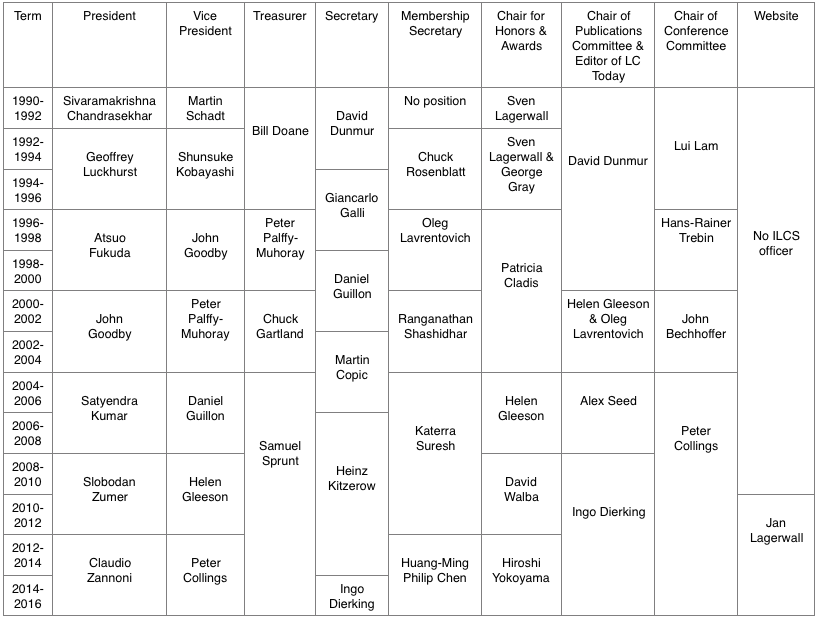
In addition to providing a reliable platform for scientific exchange and organizing the biannual International Liquid Crystal Conferences, the ILCS promotes science through a number of prizes and awards, which have been progressively introduced. Even newcomers to the field of liquid crystals now have the chance of being recognised by sending a picture or movie to the ILCS art gallery, and having the opportunity to be elected as “artist of the month”. Among young scientists, the Glenn H. Brown Prize honours the best recent dissertations every two years. This most traditional award was supplemented by the Michi-Nakata-Prize and – for a limited time during the boost of internet – by the multimedia prize. Very distinguished established scientists are awarded the status of Honoured Member of the ILCS. In order to promote established, yet young rising stars in the liquid crystal community, ILCS president Satyendra Kumar (2004-2008) raised the necessary funding and initiated two new mid-career awards. Finally, current ILCS President Claudio Zannoni (2012-2016) recently announced the Pierre-Gilles de Gennes ILCS Prize, named after the liquid crystal pioneer and Nobel Prize winner Pierre-Gilles de Gennes. This highest medal of honour will be bestowed in order to celebrate outstanding interdisciplinary research by its respective recipient.
Apart from highlights, the day-to-day business of administration and public outreach of ILCS is very important and has changed from a system characterized by file cards and printed matter to electronic communication and internet presentation. Dealing with this everyday business there have been a succession of outstanding administrative assistants supporting the ILCS at the Liquid Crystal Institute at Kent State University including Elaine Landry, followed by Brenda Decker (née Brenda Buck) until 2010, and more recently Janet Cash and Steven McCann. Hiroshi Yokoyama has now constructed a modern electronic membership administration system and Jan Lagerwall has designed and implemented the current high-quality internet web-site.
The International Liquid Crystal Society has thrived over its 25 years of existence, but the world of science is constantly changing, even to the extent of emerging new display technologies. But liquid crystal science still has a huge amount to offer to many areas of technology, and its wide applicability means that our subject is now mainstream. This has implications for the ILCS as our core subject becomes divided or even separated into other areas of science or technology. As history proves, the great triumphs in liquid crystal science and in other fields have resulted from collaborations across disciplines, and the ILCS is one important forum that supports and encourages interdisciplinary interactions. This doesn’t mean that we can wait for new developments to come to the ILCS. The Society through its conferences and meetings must move with the times and identify and support through its conferences and meetings those new areas or topics of liquid crystal science that show promise.
We must remember our origins: our liquid crystal community was created because the established scientific infrastructure was unable or unwilling to provide the support that we needed. So the ILCS should be proactive in seeking out new developments and bringing these within the compass of our scientific interests. The powerful structure of talented scientists within the ILCS coming from such a wide range of disciplines is too valuable to be allowed to decline. We have the collective experience of working in new and challenging interdisciplinary fields, and this can be applied in new ventures to the benefit of all. We can expect that our traditional areas of interest will change and expand, and we should be ready to embrace that diversity. The diversity of interests must also be matched by diversity of membership and awards. The role of women in science must be fully recognised, both in the laboratory, as already happens, but also in our intellectual structures and in our scientific leadership. The ILCS is ready for change, and by embracing change it can survive and prosper for another 25 years.
Apart from highlights, the day-to-day business of administration and public outreach of ILCS is very important and has changed from a system characterized by file cards and printed matter to electronic communication and internet presentation. Dealing with this everyday business there have been a succession of outstanding administrative assistants supporting the ILCS at the Liquid Crystal Institute at Kent State University including Elaine Landry, followed by Brenda Decker (née Brenda Buck) until 2010, and more recently Janet Cash and Steven McCann. Hiroshi Yokoyama has now constructed a modern electronic membership administration system and Jan Lagerwall has designed and implemented the current high-quality internet web-site.
The International Liquid Crystal Society has thrived over its 25 years of existence, but the world of science is constantly changing, even to the extent of emerging new display technologies. But liquid crystal science still has a huge amount to offer to many areas of technology, and its wide applicability means that our subject is now mainstream. This has implications for the ILCS as our core subject becomes divided or even separated into other areas of science or technology. As history proves, the great triumphs in liquid crystal science and in other fields have resulted from collaborations across disciplines, and the ILCS is one important forum that supports and encourages interdisciplinary interactions. This doesn’t mean that we can wait for new developments to come to the ILCS. The Society through its conferences and meetings must move with the times and identify and support through its conferences and meetings those new areas or topics of liquid crystal science that show promise.
We must remember our origins: our liquid crystal community was created because the established scientific infrastructure was unable or unwilling to provide the support that we needed. So the ILCS should be proactive in seeking out new developments and bringing these within the compass of our scientific interests. The powerful structure of talented scientists within the ILCS coming from such a wide range of disciplines is too valuable to be allowed to decline. We have the collective experience of working in new and challenging interdisciplinary fields, and this can be applied in new ventures to the benefit of all. We can expect that our traditional areas of interest will change and expand, and we should be ready to embrace that diversity. The diversity of interests must also be matched by diversity of membership and awards. The role of women in science must be fully recognised, both in the laboratory, as already happens, but also in our intellectual structures and in our scientific leadership. The ILCS is ready for change, and by embracing change it can survive and prosper for another 25 years.
- T J Sluckin, D A Dunmur and H Stegemeyer, Crystals that Flow, Classic papers from the history of liquid crystals, Taylor and Francis, London 2004.
- D A Dunmur and T J Sluckin, Soap, Science and Flat-screen TVs, Oxford University Press, Oxford 2011.
- Transactions of the Faraday Society, 29, 881-1085, 1933.
- Zeitschrift für Elektrochemie, 79, 269-347, 1931.
- Zeitschrift für Elektrochemie, 11, 299, 1905.
- Discussions of the Faraday Society, 25, 1958.
- L Lam, The Founding of the International Liquid Crystal Society, in All About Science: Philosophy, History, Sociology & Communication, eds. M Burguete and L Lam, World Scientific, Singapore 2014, p.209-240.
